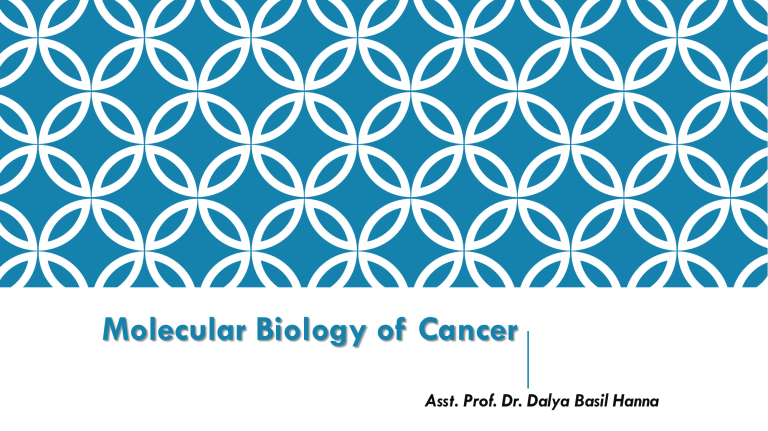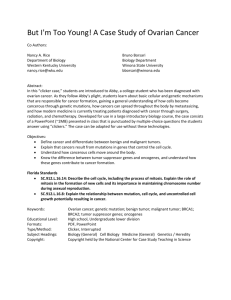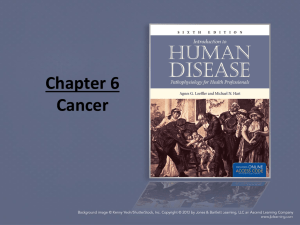
Molecular Biology of Cancer Asst. Prof. Dr. Dalya Basil Hanna MOLECULAR BIOLOGY OF CANCER Normal cells have a defined lifespan – they grow, divide, and die in an orderly fashion. A critical balance is maintained between cell growth, proliferation, differentiation, and apoptosis. In the presence of agents that promote tumor formation, such as an inherited genetic defect, a chemical carcinogen, viral infection, or irradiation, this critical balance is disrupted. When cells in a part of the body begin to grow out of control, cancer develops. MOLECULAR BIOLOGY OF CANCER Cancer is unchecked cell growth. Mutations in genes can cause cancer by accelerating cell division rates or inhibiting normal controls on the system, such as cell cycle arrest or programmed cell death. As a mass of cancerous cells grows, it can develop into a tumor. Cancer is a term for diseases in which abnormal cells divide without control and can invade nearby tissues. Cancer cells can also spread to other parts of the body through the blood and lymph systems. Therefore many types of cancer are present. MOLECULAR BIOLOGY OF CANCER Cancer is a multistep disease. The emergence of a tumor cell requires the accumulation of many – estimated to be between four and eight – genetic changes over the course of years. Gene mutations that increase the risk for developing cancer can be inherited or acquired. Acquired genetic changes result from spontaneous environmentally inflicted errors during DNA replication. or MAJOR CHANGES THAT OCCUR WHEN A CELL BECOMES CANCEROUS 1. Immortalization: The cancer cell acquires the ability to grow and divide indefinitely. 2. Transformation: The cancer cell fails to observe the normal determinants of growth; i.e. growth occurs independently of cell growth factors. Transformed cells may form a sold tumor. In order for the tumor to grow it must develop its own blood supply through the process of angiogenesis – the growth of new blood vessels. MAJOR CHANGES THAT OCCUR WHEN A CELL BECOMES CANCEROUS 3. Metastasis: Cancer cells often travel from the tissue of origin to other parts of the body where they begin to grow and replace normal tissue. This process, called metastasis, occurs as cancer cells gain the ability to invade the bloodstream or lymph vessels and other tissues. When cells from a cancer like colon cancer spread to another organ like the lung, the cancer is still called colon cancer, not lung cancer. TUMORIGENESIS The genetic changes associated with tumorigenesis can be divided into two major categories: those that result from a gain of function and those that result from a loss of function. Gain of function involves inappropriate activation of oncogenes. These genes are stimulatory for growth and can cause cancer when hyperactive. Loss of function involves inactivation of tumor suppressor genes. These are genes that inhibit cell growth and which cause cancer when they are not expressed. ACTIVATION OF ONCOGENES Oncogenes are defined as genes whose products have the ability to cause malignant transformation of eukaryotic cells. They were originally identified as the “transforming genes” carried by some DNA and RNA tumor viruses. The term “proto-oncogene” refers to cellular genes with the potential to give rise to oncogenes. For example, oncogenes are the normal counterparts in the eukaryotic genome to the oncogenes carried by retroviruses. ACTIVATION OF ONCOGENES ACTIVATION OF ONCOGENES INACTIVATION OF TUMOR SUPPRESSOR GENES The discovery of oncogenes led to the identification of another class of cellular genes, the tumor suppressor genes. Tumor suppressor gene products are required for normal cell function and, like oncogene products, play a central role in regulating cell growth and division. Cancer arises when there are two independent mutations that lead to loss of function of both tumor suppressor alleles at a locus. INACTIVATION OF TUMOR SUPPRESSOR GENES Loss can be either sporadic or heritable. If loss of one allele is inherited through the germline, an individual is said to have a “genetic predisposition” to cancer. Sporadic mutation of the second allele in a somatic cell leads to tumorigenesis. Loss of function of a tumor suppressor gene can also occur at a much lower frequency by two sporadic mutations in the same cell. Two of the best-characterized tumor suppressor genes encode the retinoblastoma (pRB) and p53 proteins. INACTIVATION OF TUMOR SUPPRESSOR GENES The retinoblastoma protein (pRB) is called the “cell cycle master switch”. This protein has been implicated in the regulation of DNA replication, cell differentiation, DNA repair, cell cycle checkpoints, and apoptosis. INACTIVATION OF TUMOR SUPPRESSOR GENES The tumor suppressor protein p53 (named for its molecular size of 53 kDa) is often referred to as the “guardian of the genome.” It regulates multiple components of the DNA damage control system, and is one of the genes most commonly induced in response to cellular stress signals. As a transcription factor, p53 can activate or repress many target genes. Over 100 genes regulated by p53 have been identified through microarray analysis. Bioinformatic studies predict that the number may be much greater – greater than 4000 human genes contain putative p53-binding sites in their promoter region. INACTIVATION OF TUMOR SUPPRESSOR GENES Role of p53 in cancer Alterations in the p53 gene have been linked to many cancers including cervix, breast, bladder, prostate, liver, lung, skin, and colon. Eighty percent of all human cancers show either deletion of both alleles on chromosome 17 leading to the absence of p53 protein (similar to pRB), or a missense point mutation in one allele. Mutations in p53 are associated with the hereditary cancer syndrome, Li– Fraumeni syndrome (named after its 1969 discoverers), which predisposes patients to brain tumors, sarcomas, leukemia, and breast cancer. Because p53 is defective in so many different types of cancers, many treatment strategies based on p53 gene therapy are being tested. DIFFERENT STEPS OF CARCINOGENESIS 1. Initiation: Mutation in one or more cellular genes controlling key regulatory pathways of the cell (irreversible)—must be a heritable DNA alteration. 2. Promotion: selective growth enhancement induced in the initiated cell and its progeny by the continuous exposure to a promoting agent. 3. Progression: results from continuing evolution of unstable chromosomes; further mutations from genetic instability during promotion—results in further degrees of independence, invasiveness, metastasis, etc. METASTASIS Metastasis of tumor characterized by the following: 1. One of the most important proteins is the cell-cell adhesion molecules (CAMs), whose main role is to bind cells to surrounding tissue. Among the CAMs, the most common protein implicated in metastasis is Ecadherin, found in all epithelial cells. In normal cells, E-cadherin acts as a bridge between adjacent cells, enabling cytoplasmic contact and sharing intracellular signaling factors responsible for inhibiting invasion and metastatic capability. Most epithelial cancers show a loss of E- cadherin function and this elimination plays a significant role in metastatic capability. METASTASIS 2. Another class of proteins involved in tissue invasion are the integrins, a widely distributed family of transmembrane adhesion receptors, which link cells to the extracellular matrix. In addition to their role in angiogenesis, they also play a central role in cell adhesion and migration, control of cell differentiation, proliferation and survival. Changes in integrin expression are also evident in invasive and metastatic cells. Successful colonization of new sites (both local and distant) demands adaptation, which is achieved by changing integrin subunits displayed by the migrating cells. METASTASIS 3. Another strategy in successful colonization is increasing expression of extracellular proteases (such as MMPsMatrix Metaloproteinases) while decreasing levels of protease inhibitors. Cells in the stroma close to cancer cells secrete active proteases, which facilitate invasion by degrading components of the extracellular matrix. This enables cancer cells to migrate across blood vessel boundaries and through normal epithelial cell layers. REFERENCES 1. Jawetz, Melnick&Adelberg’s. Medical Microbiology. 25th edition. 2016 2. Lizabeth A. Allison. Fundementals Molecular Biology. 2007. Graphicraft . Limited, Hong Kong







